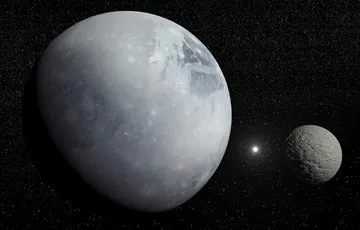
Now lets start on a memory lane!!
What is Pluto?
Pluto is classified as a dwarf planet and is also a member of a group of objects that orbit in a disc-like zone beyond the orbit of Neptune called the Kuiper Belt. This distant realm is populated with thousands of miniature icy worlds, which formed early in the history of our solar system. These icy, rocky bodies are called Kuiper Belt objects or transneptunian objects.
Pluto is about two-thirds the diameter of Earth's moon and probably has a rocky core surrounded by a mantle of water ice. More exotic ices like methane and nitrogen frost coat its surface. Owing to its size and lower density, Pluto's mass is about one-sixth that of Earth's moon. Pluto is more massive than Ceres -- the dwarf planet that resides in the asteroid belt between Mars and Jupiter -- by a factor of 14.
Pluto's 248-year-long elliptical orbit can take it as far as 49.3 astronomical units (AU) from the sun. (One AU is the mean distance between Earth and the sun: about 93 million miles or 150 million kilometers.) From 1979 to 1999, Pluto was actually closer to the sun than Neptune, and in 1989, Pluto came to within 29.8 AU of the sun, providing rare opportunities to study this small, cold, distant world.
Since its orbit is so elliptical, when Pluto is close to the sun, its surface ices sublimate, changing directly from solid to a gas, and rise and temporarily form a thin atmosphere. Pluto's low gravity (about six percent of Earth's) causes the atmosphere to be much more extended in altitude than our planet's atmosphere. Pluto becomes much colder during the part of each orbit when it is traveling far away from the sun. During this time, the bulk of the planet's atmosphere is thought to freeze and fall as snow to the surface.

How Pluto Got its Name?
Pluto is the only world named by an 11-year-old girl. In 1930, Venetia Burney of Oxford, England, suggested to her grandfather that the new discovery be named for the Roman god of the underworld. He forwarded the name to the Lowell Observatory and it was selected. Pluto's moons are named for other mythological figures associated with the underworld.
Now back to the question can Pluto become Useful?
More than a decade after it was demoted, Pluto could soon be considered useful – along with more than 100 other objects in our solar system.
Scientists have proposed a new way to define planets based on ‘the physics of the world itself,’ citing technical flaws in the definition adopted by the International Astronomical Union in 2006 as the reason for the possible overhaul.

If accepted, the geophysical definition would essentially classify all ‘round objects in space that are smaller than stars’ as planets, including Pluto, other dwarf planets, and even moons.
THE GEOPHYSICAL DEFINITION
Scientists have proposed a new way to define planets based on ‘the physics of the world itself.'
By the proposed geophysical definition: ‘A planet is a sub-stellar mass body that has never undergone nuclear fusion and that has sufficient self-gravitation to assume a spheroidal shape adequately described by a triaxial ellipsoid regardless of its orbital parameters.’
Or, simply put, ‘round objects in space that are smaller than stars.’
Scientists from NASA’s New Horizon’s mission will make their proposal http://www.hou.usra.edu/meetings/lpsc2017/pdf/1448.pdf at the Lunar and planetary Science Conference in March.
The team argues that the IAU definition is flawed in several ways, including that it only recognizes as planets those which orbit our sun.
This leaves out objects orbiting other stars or those orbiting freely through the galaxy.
Along with this, they say there are parameters which even the planets in our solar system cannot satisfy.
The new definition, they argue, would meet the needs of both scientific classification and ‘peoples’ intuition.’
By the proposed geophysical definition: ‘A planet is a sub-stellar mass body that has never undergone nuclear fusion and that has sufficient self-gravitation to assume a spheroidal shape adequately described by a triaxial ellipsoid regardless of its orbital parameters.’
Interesting Facts about Pluto
• Pluto takes the longest time of the eight planets (248 Earth years) to orbit around the sun. Because it’s the closest to the sun, Mercury has the fastest orbit, at 88 Earth days. Earth takes 365 days to orbit the sun.
• Pluto is the only known dwarf planet with an atmosphere. It is very thin and would be toxic for humans to breathe. When Pluto is at its perihelion (closest to the sun), Pluto’s atmosphere is gas. When Pluto is at its aphelion (farthest from the sun), its atmosphere freezes and falls like snow.
• It takes Pluto 6 days, 9 hours, and 17 minutes to spin once, making it the planet with the second-slowest rotation in the solar system. Venus has the slowest rotation, taking 243 days to spin just once. Jupiter is the fastest-spinning planet, rotating on average once in just less than 10 hours.
• Pluto spins in the opposite direction as Earth, which means the sun rises in the west and sets in the east. Only Venus, Uranus, and Pluto have a retrograde rotation.
• It takes about five hours for sunlight to reach Pluto. It takes eight minutes to reach Earth.
• Because Pluto’s moon Charon is almost the size of the planet itself, astronomers sometimes refer to the two as a double planet.

• In astrology, Pluto is associated with powers of creation/rebirth as well as destruction/death.
• When Pluto was considered a planet, it was the coldest of all the planets. Temperatures on Pluto can range from -240° to -218° C. The average temperature on Pluto is -229° C. The hottest recorded temperature on Earth was 70.7° C (159° F) in the Lut Desert in Iran. The coldest temperature recorded on Earth was -89.2° C (-120° F) in Antarctica. The average temperature on Earth is about 14-15° C (59° F).
• A person who weighs 100 lbs. on Earth would weigh the least on Pluto than on any other planet, at 6.7 lbs. on Pluto. A person would weigh the most on Jupiter. A 100 lb. person on Earth would weigh 236.4 lbs. on Jupiter.
• The sky is so dark on Pluto that a person would be able to see stars during the day.
• Because Pluto’s moon Charon and Pluto orbit each other, Charon appears to stand still in Pluto’s sky. Additionally, the same sides of Pluto and Charon always face each other.
• The dwarf planet Pluto is named for the ancient Roman god of the underworld. In Roman mythology, Pluto was the son of Saturn who, with his three brothers, controlled the world: Jupiter controlled the sky, Neptune controlled the sea, and Pluto ruled the underworld.
References and additional research
https://solarsystem.nasa.gov/planets/pluto/indepth
https://www.factretriever.com/pluto
Appreciation and thanks goes to:
@mystifact for providing this wonderful apportunity
@himal for letting me know this contest exist
SteemSTEM & Steemiteducation
Please consider supporting the @steemstem project. SteemSTEM is a community driven project which seeks to promote well written & informative Science Technology Engineering and Mathematics postings on Steemit. Click here to join the chat and learn more! https://steemit.chat/channel/steemSTEM. The steemstem project is run by @justtryme90, check out his channel and maybe follow
You may also want to check, @steemiteducation, a project for steemian educators and people posting educative content
Thanks For Your Time!!

